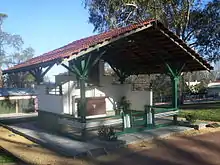Changi Museum
The Changi Museum is a museum dedicated to Singapore's history during the Second World War and the Japanese occupation of Singapore in particular.

History
After the war, the original chapel was dismantled and moved to Australia, where it was reconstructed and unveiled in 1988 as part of the Prisoner of War National Memorial in Duntroon, a suburb of Canberra.
In 1988, Singapore built a replica chapel and museum next to the Changi Prison. When Changi Prison was expanded in 2001, the chapel and museum was relocated to a new site 1 km away and the Changi Chapel and Museum was officially established on 15 February 2001. Bernard Stogden, the son of Sgt. Harry Stogden, was invited to place the cross that his father made onto the wreathed altar in the new Chapel. He was claimed to have cried while doing so, as this was one of the only chances he got to interact with his father (through his work) as "Harry" Stogden died during the war.
Collection
The museum has a collection of paintings, photographs and personal effects donated by former POWs. Among the collection is a series of paintings and sketches by a POW named William Haxworth which provide insight on the daily life of the internees during the occupation. In 1986, Haxworth's wife donated a collection of over 400 paintings and sketches to the National Archives of Singapore. The museum is also famous for its replica of the Changi Murals, a set of five murals made by the POW Stanley Warren.
Also in the museum is a collection of watercolour paintings by Mary Angela Bateman, who was among the thousands of women and children held at Changi Prison for more than three years during the war.[1]

The museum features a “no photography” rule of exhibits. The exhibits are presented in a manner that evokes strong emotions and personal connection while retaining the factual authenticity, by using excerpts from the personal writings or diaries by the former POWs.
The museum is laid out into five zones, following a chronological order: Storyboards, Changi Prison section, Changi Murals, Wartime Artists and End of War. One exhibit is the floor plan of an original Changi prison cell projected onto the museum floor, which helps visitors to experience the severe constraints and paucity of space that the internees underwent during their captivity.
References
- Nick Meo (2006-08-23). "Singapore war internee's art on show". BBC.
Literature
- Lenzi, Iola (2004). Museums of Southeast Asia. Singapore: Archipelago Press. pp. 200 pages. ISBN 981-4068-96-9.
